|
THE BYZANTINE
EMPIRE |
|
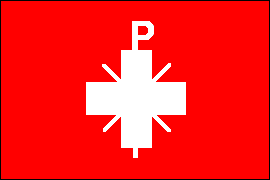
Imperial Standard After 395 AD |
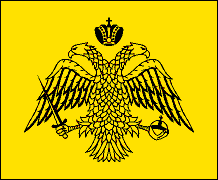
Imperial Standard 13th-15th Centuries |
|
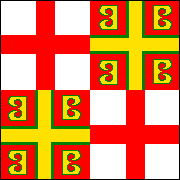 |
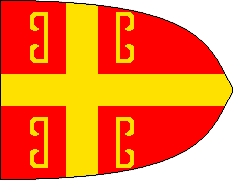 |
Imperial Standards from
The Book
of All Kingdoms 1350
Though it continued
to regard itself as the Roman Empire, Byzantium was Greek in
language and culture, and it gradually shed the remaining
vestiges of the old Roman imperium. The reign of the Emperor
Heraclius (610641) marked the decisive break with the Roman
past. He not only restructured the imperial administration and
army but replaced Latin with Greek as the official language of
the state. From that point forward the Byzantine Empire was a
Greek polity.
The question of what flags may
have been used by Byzantium is partly a matter of conjecture.
The "Imperial Standard After 395 AD" is a reconstruction based
on vague ancient sources; it displays the chrismon, a symbol for
Christ. The golden yellow double-headed eagle flag, however, is known
to have been used by the emperors of the last Byzantine dynasty, the
Palaiologos. It was adopted by
Michael
VIII Palaiologos after his recapture of the Byzantine capital,
Constantinople, from the Crusaders in 1261. The eagle with its
two heads symbolized the empire's sovereignty over European and
Asian lands. The fourteenth-century Book of All Kingdoms
ascribes a number of different flags to Byzantium, mostly with a
cross between four Greek letters Β: the initial letters of the Paleologues
dynasty's motto, Βασιλευς Βασιλεων Βασιλευων Βασιλευσιν
("King of Kings, Ruling over Kings"). The Ottoman conquest of
1453-56 extinguished the Byzantine Empire, but the double-headed
eagle was adopted by the Russian tsars, who regarded themselves
as the heirs of the Byzantine emperors. |
|
OTTOMAN GREECE |
|
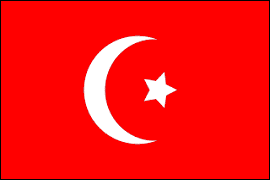
Flag of the Ottoman Empire
Early Nineteenth Century |
|
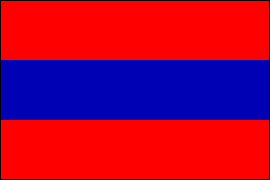 |
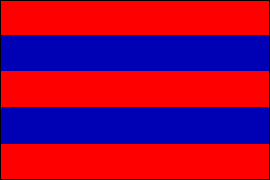 |
|
Ottoman Merchant Ensigns for Greek Vessels |
|
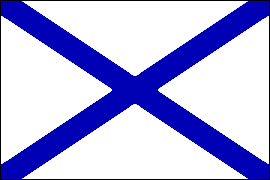
Russian Naval
Ensign
|
|
The national
flag of the Ottoman Empire was
red with a crescent and star, while the merchant ensign was
plain red. Muslim subjects who had completed
the pilgrimage to Mecca were permitted to fly a special merchant
ensign: a red flag with a horizontal central stripe of green.
Greek merchant vessels also had a special ensign: red with a
blue central stripe. Greek vessels from Smyrna used an ensign
with three red and two blue horizontal stripes. A clause in the
Treaty of
Kioutsouk Kainartzi
(1774), which ended one of the numerous wars between the Ottoman
Turks and Russia, gave Greek merchant vessels the right to
fly the Russian naval ensignthe famous Andrew Flag. This
symbolized Russia's self-proclaimed role as protector of the
Eastern Orthodox Greeks. Thereafter, Greek merchant vessels flew
the Andrew Flag almost exclusively, a practice that was
continued by Greek ships in Turkish waters even after Greece
achieved independence. |
THE WAR OF
INDEPENDENCE & THE KINGDOM OF
GREECE |
|
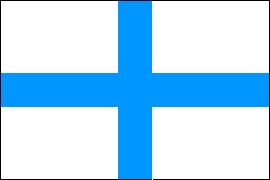
The Blue Cross
Flag |
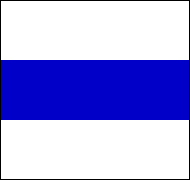
Naval Ensign of
1821 |
|
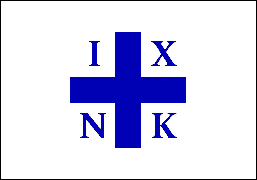
Standard
of General Plapoutas |
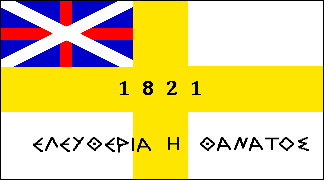
Standard
of Admiral
Miaoulis |
|
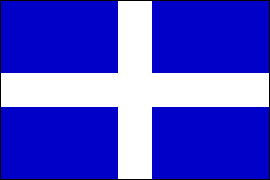
National Flag
1822-1978
|

War Ensign
1822-32
Merchant Ensign 1832-1975 & Since 1978 |
|
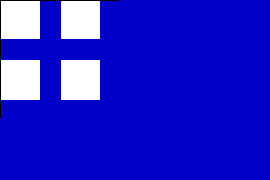
Merchant Ensign 1822-32
|
|
A wide variety of
war flags and banners was used by Greek armies and leaders
during the War of Independence. One of the most common was a
white flag charged with a light blue cross, originally the
banner of the
Kolokotronis family,
whose members were prominent in the independence movement. A
white flag with a horizontal blue stripe, dating from 1821, was
flown by Greek naval squadrons. The personal standard of General
Dimitris Plapoutas was a white flag with a blue cross and the
Monogram I X N K, standing for "Jesus Christ Victorious." The
standard or command flag of Admiral
Andreas Miaoulis, the commander of the Greek
fleet from 1822 until his death in 1836, was white with a broad
yellow cross and a canton reminiscent of the
Russian naval jack.
The date 1821 referred to the year of the outbreak of the
independence war. The motto, Freedom or Death, was the war cry
of the independence forces.
In 1822, the Greek
National Assembly proclaimed the country's independence from the
Ottoman Empire. At this time the Assembly declared blue and
white to be the Greek national colors and adopted three national
flags: blue with a white cross for use on land, nine stripes of
blue and white with a blue canton bearing a white cross for use
by warships and blue with a white canton bearing a blue cross
for merchant ships. Blue was said to represent the sky and white
the purity of the Greek cause. The cross was a symbol of
Orthodox Christianity and the nine stripes of the war ensign
represented the nine syllables of the war cry of the
independence struggle: Freedom or Death." Greece's independence
was formalized by the Treaty of London (1830) and in 1832 the country became a kingdom,
Bavaria's Wittelsbach dynasty
supplying a crowned head in the person of King Otto I. The 1822
flags were confirmed except that the merchant ensign was
dropped; merchant ships thereafter flew the cross-and-stripes
flag. Also, a new
war ensign was introduced: the cross-and-stripes flag
with the crowned arms of
Wittelsbach at the intersection
of the cross. The war flag for use on land was the plain cross
flag with the crowned arms added. Otto I followed a pro-Russian
policy that did not suit British interests
and he was forced off the throne in 1862. The new King, George
I, was a Danish prince of the Oldenburg dynasty. His accession
did not affect Greek flags, except that the war flag and war
ensign now displayed a royal crown only. Up to 1975, the plain
cross flag was the Greek national flag on land inside the
country, while the cross-and-stripes flag was used along the
coast, at sea, and overseas. |
THE HELLENIC
REPUBLIC |
|
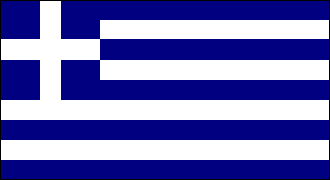
National Flag &
Ensign 1970-75 |

National Flag &
Ensign 1975-78 |
|

National Flag &
Ensign Since 1978
|
|
Greece endured many
vicissitudes from 1829 to the 1970s: assassinations, coups,
wars, invasions, occupations, civil war and general political
instability. In 1924 a revolt led to the overthrow of King
George II and the proclamation of a republic, but the monarchy
was restored in 1935. Through all this, Greece's national flags
remained unchanged. In 1970, however, the notorious Colonels'
Coup did produce changes. The plain cross flag was abolished and
the cross-and-stripes flag became the sole national flag. Its
proportions were altered from 2:3 to 7:16 and a darker shade of
blue was specified. More changes followed. The monarchy was abolished in 1973, Greece
became a republic and in 1975 the cross-and-stripes flag was
dropped, the plain cross flag becoming the national flag.
Finally, in 1978, the cross-and-stripes flag was brought back in
its traditional colors and proportions to become the national
flag. Since then it has been Greece's sole national flag, though
the plain cross flag remains in unofficial use. |















